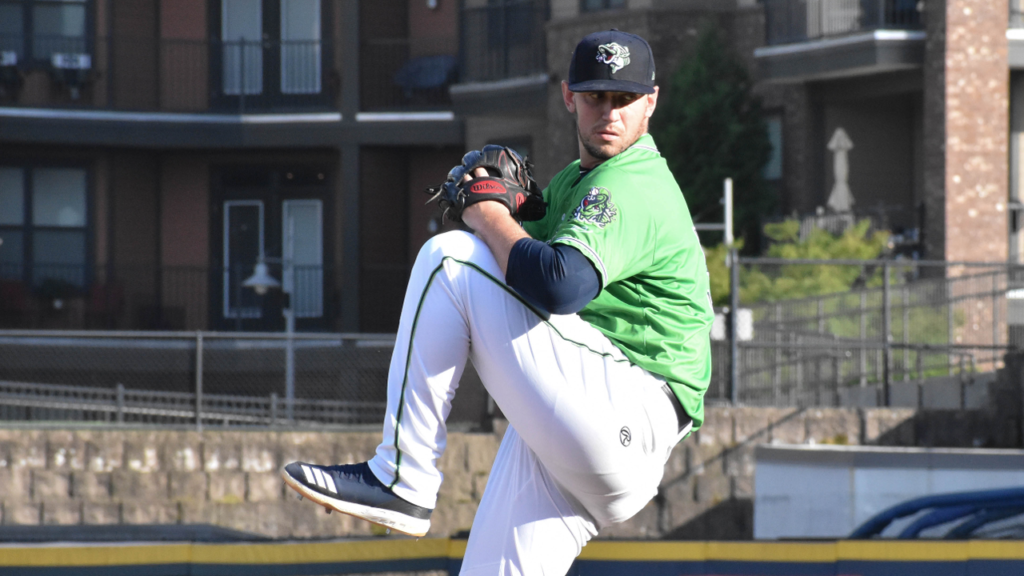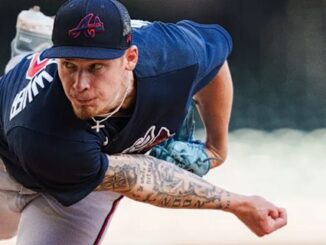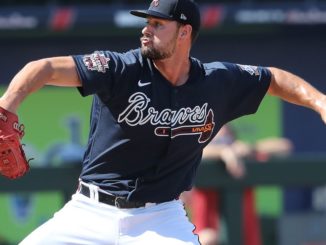
Happy March, Braves fans. The halfway point of spring training has just passed and the first cuts have been made. Games that matter will happen in just a few short weeks. While some of the team’s top prospects are still take their hacks in Grapefruit action, let’s take a look at this offseason’s rankings.
This is the fourth composite prospect list I’ve put together. Here is last year’s by way of comparison.
To make this list, I simply average the rankings across different prospect lists, then penalize each player one point (adding to their score) for each list that they were not included. That means that Drew Waters, included on all 10 lists with an average ranking of 2.80, scored a 2.80. Catcher Logan Brown showing up on 5 lists with and average rating of 29.20 scores 34.20. I have only included the prospects that showed up at least four times. There was one tie this year; I typically break ties by giving the edge to whichever prospect finished higher on a list. This year that also was a tie, so then I looked to see which finished lowest on a list. That also was a tie, so this year I have simply shown them in a tie, which also is fun because they play the same position.
For this composite ranking, I chose 10 prospect lists that covered a variety of sources and expertise.
Each of the folks who put these lists together have given this a lot of thought, and all of their write-ups are worth reviewing. I have separated the list into tiers based on their scoring strata.
Tier One
1. Cristian Pache, OF – 1.002. Ian Anderson, RHP – 2.70
3. Drew Waters, OF – 2.80
4. Kyle Wright, RHP – 4.00
Pache is the unanimous top prospect in the system, joining Dansby Swanson (2017) and Ronald Acuña (2018) among recent top prospects. Now a regular guest in the top 25 of most Top 100 prospects in baseball lists, Pache seems set to make his major league debut in 2020.
The separation between Anderson and Waters was very small. Waters appeared as the #2 prospect on six lists versus Anderson’s four, but Keith Law’s placement of Waters at #7 on The Athletic’s list proved the be enough to drop Waters down the composite list.
Tier Two
5. Bryse Wilson, RHP – 6.20
6 (tie). William Contreras, C – 7.00
6 (tie). Shea Langeliers, C – 7.00
8. Kyle Muller, LHP – 7.60
Six of the ten lists featured these four players in spots #5-8 in some order, and only one list, Keith Law’s, had one of these players sneak up into the top four spots (Wilson at #4). Of course one of the biggest and happiest debates among Braves prospect watchers is how to place young catchers William Contreras and Shea Langeliers in relation to one another, and it is somewhat delightful that they came out in the first true tie in the five years I’ve been making this list.
Tier Three
9. Braden Shewmake, SS – 9.00
10. Jasseel De La Cruz, RHP – 10.30
11. Tucker Davidson, LHP – 10.60
One of the more pleasant surprises of 2019 was how quickly 1st-rounder Braden Shewmake adapted to the pro game, hitting almost from day one at Rome and getting a quick promotion to Mississippi while demonstrating better-than-advertised defensive skills. National writers seemed more impressed than local ones, and he did not appear lower than #9 on any of those lists.
De La Cruz and Davidson were very often paired together on lists, varying as to which was placed ahead of the other. The difference-maker here was De La Cruz’s #5 ranking on Jake Berry’s Prospects 1500 list.
Tier Four
12. Huascar Ynoa, RHP – 14.00
13. Michael Harris, OF – 14.20
14. Patrick Weigel, RHP – 14.60
15. Victor Vodnik, RHP – 15.70
Perhaps fitting for a player who had such an up-and-down 2019, Ynoa had a wide variance of placement, from as high as #10 (MLB Pipleline) to #18 (Talking Chop). Mirroring that is Weigel, who faces similar starter-or-reliever questions. Six of the ten lists had Weigel ranked higher than Ynoa, but Weigel’s score was hurt by Fangraphs’ outlier #25 spot.
The other two players on the list are much younger, with 4th-round pick Michael Harris being the top-rated teenage draft pick from 2019. Last year’s under-the-radar favorite Victor Vodnik now officially seems to be no longer under the radar, appearing as high as #13 on Ben Chase’s Prospects Live list and only as low as #19 on Prospects 1500.
Tier Five
16. Freddy Tarnok, RHP – 17.50
17. Trey Harris, OF – 18.22
18. Alex Jackson, C – 18.40
19. Bryce Ball, 1B – 18.80
Up until this tier, every player had appeared on all ten lists, and three of the four players here do so as well. The exception is outfielder Trey Harris, the 32nd-rounder who just keeps hitting. There are questions about if his hyper-aggressive approach will continue to work for him at higher levels, and Baseball Prospectus was the list that was skeptical enough to keep him off their 20-man list. Fangraphs, Baseball America, and David Lee also kept Harris below the #20 mark.
National writers seem to be more willing to stay on the Freddy Tarnok bandwagon. Baseball America, Baseball Prospectus, Fangraphs, Pipeline, and Keith Law averaged a 14 ranking for the former 3rd-rounder, while Prospects 1500, David Lee, Talking Chop, Prospects Live, and Outfield Fly Rule averaged 22. Looking back at our own ranking, I do think OFR’s 23 ranking for Tarnok is too low.
After three seasons in the Braves organization, Alex Jackson’s profile has done a near 180 degree turnaround that gets him to around the same spot. When he first was acquired, most evaluators picked him for a player who’s power bat would probably get him to the majors, but who’s poor defense would likely relegate him to a second/third catcher and DH role. Thanks to remarkable hard work and excellent coaching, Jackson now profiles as a potential defensive standout… who’s lack of a hit tool will likely relegate him to a second/third catcher role in the major leagues. The difficulty in placing this kind of player in context shows in the wide differences in ranking for Jackson, from as high as #11 (Fangraphs) to a low of #26 (Talking Chop).
On a different level of difficulty is the giant 24th-round first baseman Bryce Ball. Ball has lighttower power and good enough strikezone judgement that he won’t be a 25%+ strikeout rate slugger. On the other hand, his best position is designated hitter and there’s no guarantee his approach will withstand higher-level competition. That being said, he’s gotten everyone’s attention, and he was the last player to appear on all 10 lists surveyed.
Tier Six
20. Vaughn Grissom, SS – 22.43
21. Greyson Jenista, OF – 22.44
22. Justin Dean, OF – 25.17
23. CJ Alexander, 3B – 26.00
24. Tyler Owens, RHP – 26.38
25. Jeremy Walker, RHP – 26.71
26. Kasey Kalich, RHP – 28.20
27. Daysbel Hernandez, RHP – 29.40
This tier starts with the second of the 2019 drafted teenagers, Vaughn Grissom, who appeared on only seven of the ten lists, but was placed in the top 20 on five of those seven lists.
After that we have three 2018 draftees. Jenista and Alexander had difficult seasons, with Jenista in particular taking a tumble. Dean on the other hand performed well, but at a competition level a little low for his age.
Tyler Owens is the third teenage 2019 draftee and the highest rated pitcher of the draft.
Walker, Kalich, and Hernandez are relief pitcher prospects that are rated well for different factors: Walker for his proximity to the majors and performance, Kalich for his draft pedigree and strong start to his pro career, and Hernandez for the quality of his fastball and performance at high-A.
Tier Seven
28. Stephen Paolini, OF – 32.80
29. Mahki Backstrom, 1B – 33.25
30. Phil Pfeifer, LHP – 33.67
31. Logan Brown, C – 34.20
32. AJ Graffanino, SS – 35.00
33. Beau Philip, SS – 35.50
34. Jefrey Ramos, OF – 36.00
35. Trey Riley, RHP – 36.80
36. Ricky DeVito, RHP – 37.00
The final tier features four 2019 draftees, including two more teenagers in Paolini and Backstrom. I think it’s fair to say that prospect evaluators are impressed with the depth of the Braves latest draft.
It’s probably fair to say that if Pfeifer was 23 years old instead of 27, he would have placed much higher on the list. Even so, there seems to be cautious optimism that Pfeifer’s career revival will take hold, and he appeared on six of the ten lists.
Logan Brown has impressed enough with his solid all-round game to grab some attention, and despite a very rough season in Rome, Trey Riley’s raw stuff still intrigues enough watchers that he appeared on half of the lists. Likewise AJ Graffanino made enough of an impression in 2018 with his all-round game that four of the ten lists saw fit to include him despite missing all but 2 innings of the 2019 season due to injury and illness.




Leave a Reply